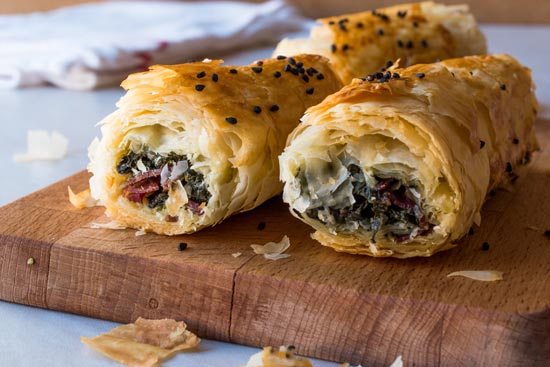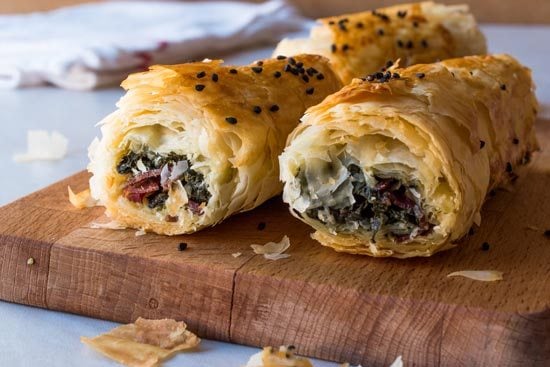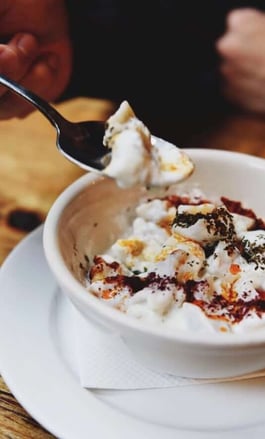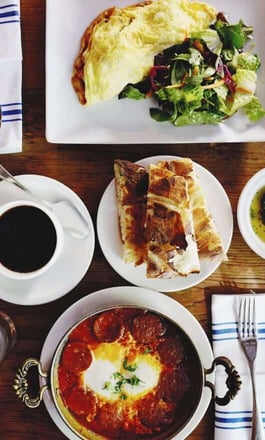Turkish Pastry With Spiced Beef and Pistachios (Borek)

Borek is a traditional savory Turkish pastry which is filled with spiced meat and then baked to perfection.
Borek is a term which covers a very wide range of savory Turkish pastry recipes, all of which are made by creating different kinds of fillings and inserting them inside very thin loaves, and then cooking the entire stuffed loaf. The origins of borek are somewhat obscure, although it is believed that this tasty dish originated centuries ago in the area which is now central Turkey. From there, it emanated throughout the entire region during Ottoman times, and it presently enjoys a status of widespread acceptance and appreciation, far beyond its original place of development.
In past generations, borek was made in a process that most people today would consider fairly tedious because it involved creating the dough for the loaf to be filled, and then delicately rolling it out to a perfect state of thin-ness. The reason this was such a delicate operation is that the dough had to be rolled to a thickness which was thin enough to avoid dominating the flavor of the entire product, yet strong enough to adequately contain the stuffing ingredients without breaking apart or being punctured.
Many modern Turkish chefs and weekend baking hobbyists prefer to simply purchase the yufka, which are pre-made shells that hold the stuffing. This is very similar to the approach used for making baklava, or the sweet Italian dessert known as cannoli. While purists may object to the pre-made shell approach, convenience probably dictates that it will become the most frequently adopted method of making Borek, now and in the future.
The recipe described below will produce a flaky Borek, very similar to a puff pastry. It also includes many of the most commonly used Middle Eastern spices, so as to produce a highly aromatic, highly flavorful version of the traditional Turkish borek treat. While many recipes do not call for this, the present recipe also includes a dried apricot, for the purposes of balancing out all the spices with a touch of sweetness.
To add a final satisfying crunch, roughly chopped pistachios are also included in this recipe, which can then be served as a perfect side dish for either lunch or dinner. Many Turkish people are also very happy to take Borek along with them as a tasty treat when they are on the go a great deal, and simply don’t have time to sit down to a more formal meal.
Ingredients for Preparing Turkish Pastry with Spiced Beef
While you will undoubtedly encounter dozens if not hundreds of different recipes for various kinds of borek, the present recipe is for borek with spiced beef and pistachios. Anyone who makes borek fairly often generally comes up with their own personal favorite recipe, including all of their own kinds of stuffing.
Ingredients for the stuffing:
- Salt and pepper
- 1/4 teaspoon of ground up coriander
- 1/4 teaspoon of ground-up ginger
- 1/4 teaspoon of ground-up cinnamon
- 1/2 teaspoon of ground-up cumin
- 1/2 teaspoon of ground-up allspice
- 1/2 teaspoon of paprika
- 1 teaspoon of Turkish flakes of red pepper
- 10 g of finely chopped dried apricot
- 2 tablespoons of olive oil
- 1 onion which has been finely chopped
- 300 g of minced beef
- 30 g of pistachios which have been roughly chopped
- 2 tablespoons of butter
- 2 tablespoons of flat leaf parsley which have been chopped
Ingredients for the borek:
- Sesame seeds or Nigella seeds, which will be sprinkled on the top of the pastry
- 1 egg
- 12 sheets of filo pastry
- 100 mL of olive oil
- 100 mL of cold milk
- 100 mL of yogurt

Cumin, coriander, ginger, cinnamon, cumin, paprika, and allspice contribute to the rich flavor of this flaky Turkish pastry treat.
Cooking Directions
After preheating your oven to 355°F, sauté the onion in olive oil over a medium heat, while regularly stirring to prevent burning. Do this until the edges of the onion are slightly brown, which should take between 10 and 15 minutes. Increase the heat on your stove and add in the meat, after which you will need to break it up into smaller pieces as it begins to cook.
After the meat has cooked through entirely, you can add the spices, apricot, and pistachios, then continue frying this mixture for about three minutes, all the while stirring regularly. Remove the pan from the stove, and mix in the butter as well as the parsley.
In a mixing bowl, add the egg and olive oil together and whisk them until they are well blended, after which you can add in the yogurt and milk, whisking the entire mixture until well blended again.
Next, you’ll need to use baking parchment to line a baking sheet, so that your pastry shells won’t get stuck on the bottom. Then you can take out your filo pastry and cover it with a somewhat dampened cloth. Be sure not to overlook this step, since filo has a tendency to dry out extremely fast, and that will interfere with all the following steps.
Take two sheets of your filo pastry and place them one on top of the other, then cut the sheets in half on the longer side. By starting out with sheets which are roughly 38 x 32 cm, you’ll end up with two double sheets that are approximately 38 x 16 cm.
Next, spread a tablespoon of the egg mixture on each one of your filo sheets, ensuring that the top of the pastry is completely moistened, without being saturated or wet all the way through.
Then you can add about a tablespoon of filling at the short end, which is farthest from you. Now roll that end up until all of the filling has been completely covered, and fold in the pastry sides before continuing to roll.
When you reach the end of the pastry sheet with rolling, you can place it on the baking parchment with the side containing the seam facing down. Repeat the same procedure as many times as necessary until you run out of filling.
Next, brush the freshly rolled borek with the same egg mixture used before, making sure to apply only enough to moisten the borek without saturating. Sprinkle the sesame seeds over the top, and then roast until the borek are golden brown. This should take between 30 and 40 minutes, after which the borek should be allowed to rest for 5 to 10 minutes before serving. Your guests will be delighted by this flaky and flavorful Turkish pastry.







